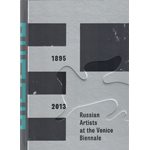In 2014 the Russian Pavilion at the Venice Biennale will celebrate its 100th anniversary. As the anniversary year approaches, Stella Art Foundation with the support of the Banca Intesa is presenting a book dedicated to the history of the Russian Pavilion and of Russian involvement in the Venice Biennale. The book is the first-ever attempt to fully analyse and understand the historical and cultural contribution made by Russian artists to the world’s greatest art event, from 1895 to the present day.
Stella Kesaeva, the President of Stella Art Foundation, writes in her foreword to the book:
“In the autumn of 1913, after five years of negotiations between the Venice Biennale administration and the Imperial Academy of Arts, a site for a Russian pavilion was chosen in the Giardini, the Venice municipality gave its permission for construction to proceed and the architect, Alexei Shchusev finalised his design project. On 29 April 1914, shortly after the opening of the 11th Biennale, the Russian pavilion was ceremonially opened by Grand Duchess Maria Pavlovna. From that day to the present the pavilion has been the main venue for the exhibition of Russian art in Venice. But Russian artists had already played an important part in the Biennale ever since the first Venice Exhibition of 1895, nearly 20 years before the pavilion was built. And they have continued to participate in Biennale art events when the national pavilion has been closed for either technical or (in the time of the Cold War) ideological reasons. A total of 800 Russian artists have shown their works at the Biennale, from the leading names of Russian art (Repin, Malevich, Kabakov) to lesser known names and some, which are now almost entirely forgotten.”
Professor Antonio Fallico, Chairman of the Board of Directors of Banca Intesa:
“Venice has always been a meeting place for the cultures of Italy and Russia. We know and feel the deep influence of Byzantine culture on the Russian world. The influence of Byzantium on Venice is no less evident. Perhaps for this reason the city beloved of Joseph Brodsky is spiritually close to Russians and reciprocates with a special empathy towards them. This was true before the Revolution and through the Soviet period. It is still true today. Our Bank appreciates this spiritual link and is keen to nurture it as an important contribution to the future development of European culture and world culture.”
The book has three parts. The first consists of articles about the history of the Russian section in the early years of the International Exhibition and the history of the Russian and USSR Pavilion in various periods (before the Revolution, through the USSR years and up to the present day).The second and central part of the book offers a chronology, documenting Russian participation in the Biennale from 1895 to 2013.The third part provides indexes of all the Russian commissioners, curators and artists who have been represented at the Pavilion and at the Biennale’s main and collateral events with short biographical information on each of them.
A number of archive documents are published in the book for the first time:
– documents relating to exhibitions in the Russian section during the first years of the Biennale, before the Pavilion was built, including the exhibitions of 1897 (curated by Ilya Repin) and 1907 (curated by Sergei Diaghilev);
– the first design for the Russian Pavilion (dating from 1910 and never built);
– the letter from Malevich, withdrawing his works from the exhibition at the Soviet Pavilion in 1924;
– materials describing participation in the Biennale by Russian émigré artists outside the Soviet Pavilion;
– materials concerning the visit to Moscow in 1975 by the Biennale President, Carlo Ripa di Meana;
– materials from the Biennale of Dissent in 1977;
– accounts of post-Soviet exhibitions in the Pavilion (since 1990);
– photo documents from the Historical Archive of Contemporary Art (ASAC) in Venice and the archive of the Russian Academy of Arts;
– many other materials from Italian and Russian archives.
The book includes numerous reproductions of works that have been displayed in the Russian section and the Russian/USSR Pavilion at Biennales from 1895 to the present.
Contributors, editors and publishers
Russian Artists at the Venice Biennale, 1895-1913
Moscow: Stella Art Foundation, 2013. 768 pages, 280 illustrations
Authors: Nikolai Molok (editor), Faina Balakhovskaya, Matteo Bertelè, Boris Groys, Ekaterina Degot, Andrei Kovalev, Maria Kravtsova, Geraldine Norman, Sandra Frimmel.
Design: Faro Studio / Andrei Shelyutto, Irina Chekmareva.
The book is published in two versions, in English and in Russian.
With the support of Mercury Group
General partner: Banca Intesa
